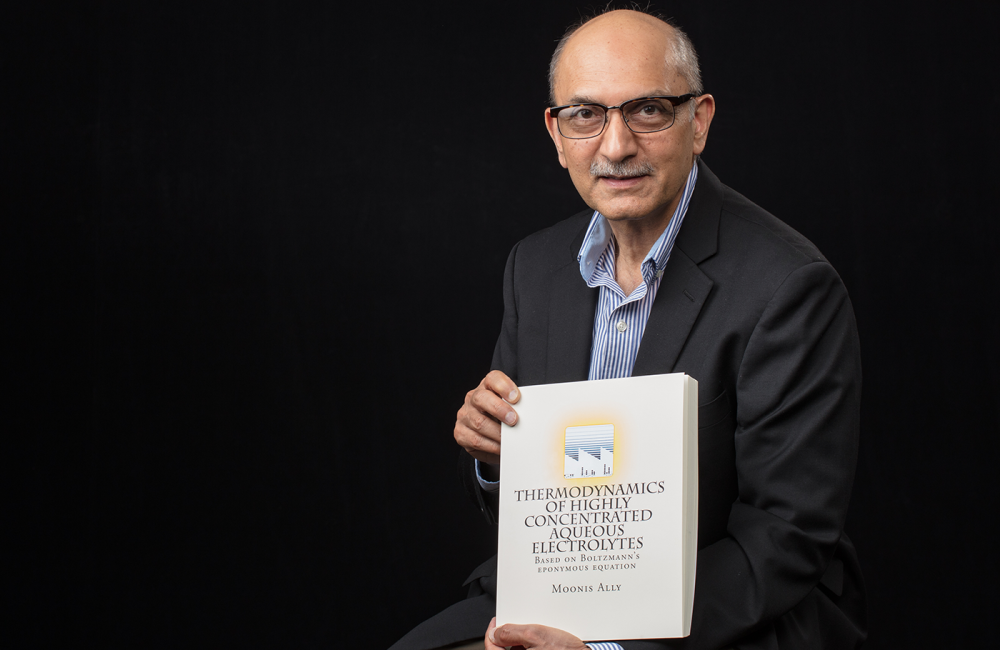August 21, 2018 – Of all the roles Moonis Ally has held during his life, the title of ‘problem solver’ resonates with him the most. Ally’s commitment to problem solving, and ultimately to helping others solve problems, is what led to the theory bearing his name and the book summarizing his work at the Department of Energy’s Oak Ridge National Laboratory.
Beginning as an engineer at ORNL in the 1980s, Ally’s first task at the Lab was harnessing the low-level waste heat that was released by nuclear reactors into the environment and raising that heat to a usable temperature without assistance from a primary energy source. Ally equates this problem to boiling a pot of water without using a stove.
Ally and his colleague Jerry Braunstein, former ORNL physical chemistry researcher, developed the Ally-Braunstein Theory, which predicts vapor pressure, density, molar volume and crystallized forms but only requires two parameters: energy and entropy.
Robert “Robin” Stokes, an expert in electrolytes, reviewed the theory, and through their correspondence, Ally was inspired to gradually expand Stokes’ work into a comprehensive theory of highly concentrated aqueous electrolytes. Ally and Stokes also formed a mutual friendship and comradery through the shared focus of their research.
“The process was crucial. The process was talking to other scientists, identifying what they were trying to solve and then developing a theory that will solve that problem,” Ally said. “I would not have developed the theory to the extent I have without correspondence with other scientists.”
The theory’s prediction significantly reduced the large expenditure of time and money experimentation would have required to generate the same data. One thing that was not predicted, however, was the theory’s diversity of applications, from the optimal amount of salt to use for snowy and icy roads to modeling climate change.
Paul Zambino, a mycologist and plant pathologist with the U.S. Department of Agriculture, was researching a fungus found on diseased pine trees and needed a way to preserve samples. When Zambino reached out to Ally, the theory revealed the necessary solute concentrations to preserve spores at different humidity levels.
“It was totally beyond the area of research that I was focused on, but I was gratified to help solve a problem in agriculture research,” Ally said.
Olaf Hellmuth, a researcher from the Leibniz Institute for Tropospheric Research (TROPOS), contacted Ally for help applying the theory to tropospheric aerosol particles. Industrial production creates these tiny particles as a byproduct that are suspended in air and flood the atmosphere with pollution. These particles impact climate conditions, but many unknowns still persist, which makes modeling necessary to determine the global climate effects.
Hellmuth and his colleagues published the details of the theory in a series on Nucleation Theory and Applications. Ally’s theory was successfully applied by scientists at TROPOS to measured deliquescence and efflorescence humidities . Hellmuth’s publication was the first time the theory had been named the Ally-Braunstein theory.
“Before, I said. ‘Stay tuned. The best is yet to come.’ I was enthusiastic about what all this theory would do, and I still didn’t realize things would get much, much better,” Ally said. “This application to climate change has been the most surprising and the most rewarding.”
Hellmuth encouraged Ally to write a book. Ally considered this an opportunity to create a user-friendly guide to applying his theory, authoring “Thermodynamics of Highly Concentrated Aqueous Electrolytes: Based on Boltzmann’s eponymous equation.” Rather than just listing the steps, Ally individually derived all of the theory’s calculations and provided milestones between steps to guide readers through his theory. The book was also an accumulation of Ally’s work throughout his career.
“Anyone who wanted to reproduce my work should be able to do it,” Ally said. “The book summarized a lot of work that I had done at ORNL. I wanted to write it for students but also for myself.”
Although only a portion of the book has been applied to the climate change modeling, more applications of the Ally-Braunstein theory may arise in the future. Currently, Ally is working as a member of the ORNL Building Technologies Research and Integration Center, and he continues to apply and evolve his theory.
ORNL is managed by UT-Battelle for DOE’s Office of Science. The Office of Science is the single largest supporter of basic research in the physical sciences in the United States, and is working to address some of the most pressing challenges of our time. For more information, please visit http://energy.gov/science/. —Shelby Whitehead


